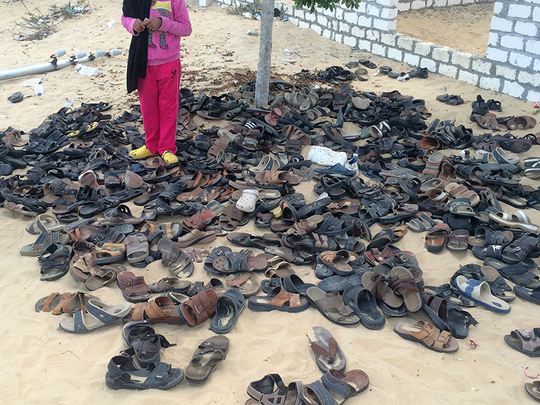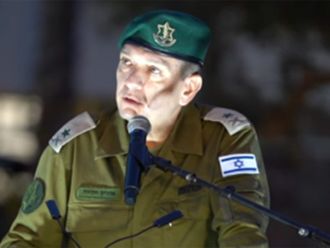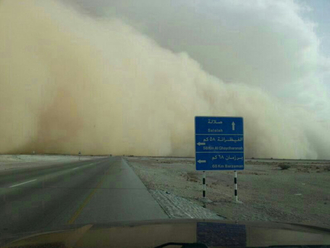
CAIRO: One day in early November, a small group of elders in a dusty town in the northern Sinai Peninsula handed over three people accused of being Daesh terrorists to Egyptian security forces. It was not the first time — they had handed over at least seven other people accused of being militants in the previous few months.
Three weeks later, militants stormed a packed mosque in the town, Bir Al Abed, during Friday prayers, killing 311 people in Egypt’s worst terrorist attack.
While the attack was rooted in rising religious tensions between the local affiliate of Daesh and the town’s residents, Bedouins who largely practise Sufism, a mystical school of Islam that the militant group considers heresy, the motive appears to have gone beyond the theological dispute.
It was payback, residents and officials said, for the town’s cooperation with the Egyptian military and a bloody warning of the consequences of further cooperation.
“I am sure this was an act of revenge,” Gazy Saad, a member of parliament from North Sinai, said of the mosque attack. “It’s not just about Sufism. They were clearly trying to send people a message.”
Bir Al Abed has long been one of the most pro-military towns in Sinai, going back as far as the uprising that toppled President Hosni Mubarak in 2011, local leaders say. After militants and criminals stormed police stations and seized weapons during the uprising, residents took the weapons and returned them to the authorities in 2014 after they regained control of the area. Hundreds of young men from the area apply for police and military service every year, although they are routinely rejected, local officials say, because the state distrusts Bedouins.
“They love the military and the state,” Saad said. “The terrorists wanted to punish them for this.”
No one has claimed responsibility for the attack, but Daesh had singled out the town for destruction, and the attackers carried Daesh flags.
The government has not allowed foreign media into Bir Al Abed, so The New York Times interviewed more than 30 residents, security officials and local political and clerical leaders by phone for this article. Several spoke on the condition of anonymity, fearing reprisals by the militants.
New details of the attack also emerged.
As the militants began to rake the congregation with machine-gun fire, two boys, ages 10 and 15, cowered in a bathroom stall, listening, petrified, to the screaming and gunfire.
After awhile, two militants entered the rest room to make sure they had not missed anyone. “How many people did you kill?” one asked, as they kicked open each stall, the boys’ mother said.
“A hundred,” the other replied.
Just before they reached the stall where the boys were hiding, a third militant walked in and told the others to position themselves elsewhere, the mother said. The boys survived.
The attack came after more than a year of escalating tensions between the radical Sunni Muslims of Daesh and the Sufi residents of Al Rawdah, a district in Bir Al Abed. The campaign began in November last year with the beheading of a blind, elderly Sufi cleric from the nearby town of Al Arish, who was accused of practising witchcraft.
Three weeks later, in an interview published in a Daesh magazine, one of the group’s commanders in Sinai derided Sufi practices as “sorcery and soothsaying” and identified Al Rawdah and two other predominantly Sufi districts as places the group intended to “eradicate.”
Attacks on three Sufi shrines in the district soon followed.
“Every time they build one, the militants destroy it,” said Fakri Ismail, whose brother was killed in the attack. “The threats started after that.”
The militants began sending text messages to tribal elders and distributing flyers telling people to abandon Sufism and “return to Islam.”
They called some residents by phone and threatened to kill them if they did not abandon Sufi rituals like the building of shrines and the worship of saints, which they consider polytheistic.
They twice attacked the home of a beloved cleric, Shaikh Hussain Al Greir.
And they regularly sent men to the mosque to demand that the imam preach jihad. He refused.
Most people were too afraid of the militants to report them, but some of Al Rawdah’s elders complained to the police.
These complaints were not ignored, but the authorities prioritised other security operations in the area, local officials said. No one thought the militants would attack a mosque, they said.
The military had been improving ties with Bedouin leaders across Sinai this year. In October, the Tarabin tribe, one of the biggest in Sinai, announced that it would help the military hunt down Daesh operatives.
Shortly after the announcement, several local residents who were believed to be cooperating with the government in Al Rawda and elsewhere were killed. In November, 14 men from central Sinai were kidnapped and interrogated by Daesh over accusations that they had been agents for Egyptian security.
At the same time, Daesh was in upheaval. As its once vast caliphate in Iraq and Syria crumbled, it was forced to rely more on other franchises, like the one in Sinai, to spread its tactics of sectarian hate and division. The Sinai group, which arose after the Egyptian military overthrew the country’s Islamist president, Mohammad Mursi, in 2013, was considered one of its most effective affiliates, responsible for shooting down a Russian jetliner in 2015, killing 224 people.
But it had since split into two factions, and this division, according to security officials and residents, may go furthest in explaining the wholesale carnage of the mosque attack.
After the group tried and failed to take over a town in eastern Sinai in 2015, the military carried out a devastating air campaign, leaving the group in disarray and sending a weak, splinter group west to Al Arish. The Al Arish group began taking recruits from outside the region — from mainland Egypt as well as neighbouring countries like Syria, Sudan and Libya — who had no tribal ties to the Bedouins of Al Rawdah.
“The attack on the mosque was almost certainly carried out by the Al Arish group,” said Ahmad Saqr, a former senior Sinai official and an expert on the militancy there. The main Daesh Sinai group “would not approve” of the mass killing, he said, “but the Arish people are happy to kill anyone and everyone.”
Even in a land tormented by violence, the scale of the attack on the Rawdah mosque last Friday was stunning.
More than two dozen gunmen travelling in five vehicles stormed the mosque when it was at its most crowded, during Friday Prayer, exploding a bomb and then spraying the worshippers with gunfire.
Some militants positioned themselves outside the mosque and its windows to mow down people as they tried to flee. Parked cars were set on fire to hinder escape.
The imam who had refused to preach jihad survived by hiding under the bodies of two of his friends and playing dead, he said. At one point, he said, a militant stood on top of him to make sure he was really dead.
After they killed as many people as they could at the mosque, including 27 children, some of the militants went house to house, killing any man they found.
Residents and experts say there may have been another reason for the high death toll.
Despite the fact that there are three government security installations within 12 miles of the mosque, ambulances arrived at the scene well before the police and the military forces did, residents and victims said. They attributed the delay to a widespread presumption, even among some security officials, that Egyptian security forces fear armed conflict.
The spokesmen for the police and the military could not be immediately reached for comment.
“Regardless of how you look at it, the government could have done more,” Saqr said.
After the gunfire stopped, the boys emerged from the bathroom to find their mother wailing as she flipped over their dead neighbours and friends to search for her husband. She found his body lying over their 5-year-old son. The father, 52, had taken a bullet to the head, but apparently saved the child.
“We were standing in a sea of corpses,” said the mother, 38. “If it were not for my husband’s body, I would have lost my son. The terrorists can have Al Rawdah, Friday Prayer and everything else. We are staying home.”












